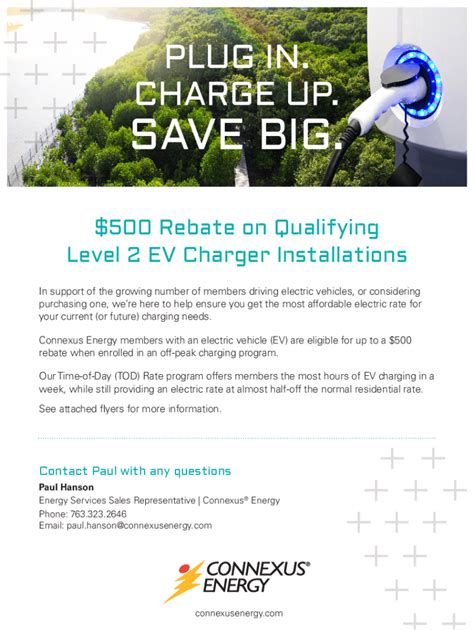Charge Ahead: Unlocking the Benefits of EV Charging Station Rebates
As electric vehicles (EVs) become increasingly popular, the demand for charging infrastructure is on the rise. In response, many governments and organizations are offering rebates for the installation of EV charging stations. These incentives can significantly reduce the cost of installation, making it easier for businesses and homeowners to embrace electric vehicle technology. This article delves into the benefits of EV charging station rebates and how they can help accelerate the transition to a cleaner, more sustainable future.
1. Understanding EV Charging Station Rebates
EV charging station rebates are financial incentives provided by various levels of government—federal, state, and local government—as well as utility companies. The purpose of these rebates is to encourage the installation of EV chargers to support the growing EV market. The rebates can cover a range of expenses, including equipment costs, installation fees, and sometimes operational costs.
2. Financial Benefits of Rebates
One of the most immediate advantages of EV charging station rebates is the financial relief they provide. With costs for commercial-grade charging stations often exceeding $10,000, rebates can cover a substantial portion of these expenses, allowing both businesses and homeowners to invest in EV infrastructure without breaking the bank.
For example, a rebate can range anywhere from $500 to several thousand dollars, depending on the program and location. This not only lowers the upfront costs of purchasing and installing a charging station but can also lead to quicker returns on investment (ROI) as EV adoption continues to grow.
3. Environmental Benefits
Transitioning to electric vehicles is critical for reducing greenhouse gas emissions and combating climate change. By investing in EV charging stations, individuals and businesses contribute to a larger ecosystem that supports sustainable practices. EV charging station rebates incentivize this shift, enabling widespread adoption of electric vehicles and facilitating the reduction of fossil fuel dependency.
4. Enhanced Property Value
For homeowners, having an EV charging station can add significant value to a property. As more people opt for electric vehicles, having a charging station on-site makes a home more appealing to potential buyers. Similarly, businesses equipped with charging infrastructure can attract a growing customer base of environmentally conscious consumers. The financial incentive from rebates can help offset the initial investment, enhancing property value well beyond what was spent.
5. Increased Fleet Efficiency for Businesses
For businesses looking to electrify their fleets, EV charging station rebates provide an essential financial boost. Transitioning to electric delivery vehicles or service vans can result in significant savings on fuel and maintenance costs. The installation of charging infrastructure can be tailored to the unique needs of a business, allowing for optimized operations and improved efficiency.
6. Community Engagement and Support
By participating in rebate programs and installing EV charging stations, businesses and homeowners contribute to local community support. Enhanced charging networks can encourage EV adoption within local communities, fostering community engagement and participation in sustainability efforts. Many local governments also use these rebate programs as a means to educate the public about the benefits of electric vehicles and clean energy practices.
7. Availability of Programs
Various rebate programs are available depending on where you live. Local utility companies often have incentives tailored to their service areas. For example, California’s Clean Vehicle Rebate Project (CVRP) provides significant incentives for EV buyers and those installing charging stations. It’s essential to research the specific requirements and eligibility criteria in your area to maximize available savings.
8. How to Apply for Rebates
The process for applying for EV charging station rebates can vary by program, but it generally involves the following steps:
- Research available rebate programs in your area.
- Purchase an eligible charging station directly from a certified supplier.
- Complete any required paperwork, including proof of purchase and installation.
- Submit your application within the program’s designated time frame.
9. Future Trends in EV Charging Infrastructure
As the EV market continues to evolve, we can expect further enhancements in charging infrastructure. Demand for EV charging stations is expected to grow, supported by advancements in technology such as fast charging and wireless charging solutions. Additionally, increased emphasis on renewable energy sources and smart technology will likely shape the future landscape of EV charging—making it more accessible, efficient, and user-friendly.
Conclusion
EV charging station rebates are an integral part of promoting electric vehicle adoption and building the necessary infrastructure for a sustainable future. With financial incentives available, the barriers to installing charging stations are significantly lowered, paving the way for broader acceptance of electric vehicles in both residential and commercial settings. As more individuals and businesses participate in these programs, the collective impact on our environment and economy could be profound, ultimately leading to a cleaner, greener world.
FAQs
1. What types of charging stations are eligible for rebates?
Eligibility typically includes Level 2 and DC fast charging stations, but it’s essential to check specific program guidelines for details.
2. How much can I save with EV charging station rebates?
Savings can vary widely based on location and specific programs, ranging from $500 to several thousand dollars.
3. Is there a limit to how many charging stations I can install and claim rebates for?
Some programs may have limits on the number of rebates per household or business, so it’s important to check the specific terms and conditions.
4. How long does it take to receive a rebate after applying?
Rebate processing times can differ by program, but applicants should typically expect a response within a few weeks to a couple of months.
5. Can I combine state and federal rebates?
Yes, in many cases, it is possible to combine various incentives, but confirm eligibility with program administrators to ensure compliance.
Download Ev Charging Station Rebate
